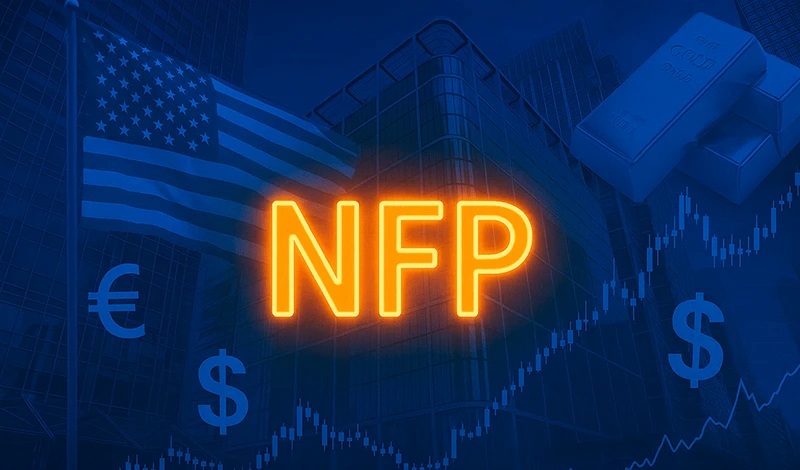Few events capture the attention of global traders quite like the release of the U.S. Non-Farm Payrolls (NFP) report. In just a few lines of data, markets can shift direction, liquidity can thin out, and volatility can spike to levels rarely seen on a normal trading day. For many, NFP Friday is a test of both preparation and discipline.
In this article, we will explore what NFP is, why it matters, when it is published, how it affects major currency pairs and gold, and what traders should keep in mind when navigating the turbulence of its release.
What Is Non-Farm Payrolls?
The Non-Farm Payrolls report, published by the U.S. Bureau of Labor Statistics, measures the change in the number of paid employees in the U.S., excluding farm workers, government employees, private household staff, and employees of nonprofit organizations. It is released on the first Friday of every month at 8:30 a.m. Eastern Time.
The report is considered one of the most important indicators of the health of the U.S. economy. Alongside the headline payroll figure, it also includes the unemployment rate, average hourly earnings, and participation rate. These components collectively shape expectations for U.S. economic growth and inflation — both central to the Federal Reserve’s monetary policy decisions.
Why Is NFP So Important for Traders?
NFP is not just a set of numbers — it is a direct signal about the pace of the U.S. economy. When job growth is strong and wages rise, it may suggest a tightening labor market and higher inflationary pressures. This often fuels expectations of interest rate hikes, pushing the U.S. dollar higher. Conversely, weak job growth can point to economic slowdown and may lead to expectations of monetary easing.
For traders, this means the NFP is often a catalyst for:
- Sudden repricing of U.S. interest rate expectations.
- Fast shifts in demand for safe-haven assets such as gold.
- Sharp moves in major forex pairs where the U.S. dollar plays a dominant role.

When Does It Happen?
The NFP report is published monthly, typically on the first Friday, at 8:30 a.m. Eastern Time (14:30 Central European Time). Traders worldwide mark this moment on their calendars, often reducing or adjusting their positions in advance due to the expected volatility.
Market Impact of NFP
Major Forex Pairs
- EUR/USD: Often the most reactive pair. A strong NFP print usually strengthens the dollar, pushing EUR/USD lower, while a weak report tends to send it higher. Liquidity can vanish for seconds after the release, making spreads much wider than usual.
- USD/JPY: Moves are shaped not only by the dollar but also by risk sentiment. A strong NFP can lift yields, boosting USD/JPY, while a weak print can trigger safe-haven flows into the yen.
- GBP/USD: While driven mainly by domestic U.K. factors, this pair also reacts sharply to NFP due to dollar dominance. Traders must remember that thin liquidity around the release can exaggerate moves.
Gold (XAU/USD)
Gold is extremely sensitive to NFP because of its connection to U.S. interest rates and the dollar. Strong labor data may fuel expectations of higher rates, pressuring gold lower. Weak data often sparks rallies as investors seek protection in the metal. Volatility in gold during NFP can be extreme, with $20–$30 intraday swings not uncommon.
What to Watch Beyond the Headline
Many traders focus only on the headline job creation figure. However, markets often move more on the details:
- Unemployment Rate: Indicates the share of the labor force without work. A surprise here can move markets independently of payroll numbers.
- Average Hourly Earnings (AHE): A measure of wage growth, closely tied to inflation expectations. Strong wage growth can push the Fed toward tightening even if payrolls are soft.
- Labor Force Participation Rate: Helps traders understand if changes in unemployment are due to genuine job creation or people exiting the labor market.
- Revisions: Previous months’ data are revised frequently. Markets sometimes react more to revisions than the current number, especially if they significantly alter the recent labor market picture.
Best Practices During High-Volatility Releases
Trading during NFP can be as rewarding as it is risky. Here are a few important practices to consider:
- Expect Wider Spreads: Liquidity providers widen spreads around the release to protect against rapid price swings.
- Beware of Slippage: Orders may be executed at worse prices than expected due to the speed of movement.
- Manage Position Size: Smaller sizes can help limit the impact of unexpected moves.
- Use Caution with Pending Orders: Stop and limit orders can trigger at less favorable levels when liquidity vanishes.
- Don’t Overtrade: Many traders find it better to wait until initial volatility settles before entering positions.
Conclusion
The U.S. Non-Farm Payrolls report is more than just a headline number — it is a market-moving event that shapes expectations for monetary policy, impacts major forex pairs, and drives volatility in gold. By understanding not only the headline but also the underlying components and revisions, traders can better interpret market reactions.
At NordFX, traders have access to both major currency pairs and gold on MetaTrader platforms, where fast execution and flexible trading conditions make it possible to navigate even the most volatile sessions with confidence.
Go Back Go Back
